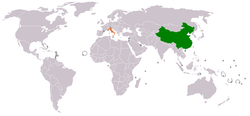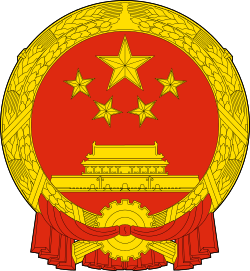China–Italy relations
 |
|
China |
Italy |
|---|---|
Bilateral relations between China and Italy date back to Imperial China and Ancient Rome but the ties between Italy and the People's Republic of China only formally began on 6 November 1970.[1] News of Italy's recognition of the People's Republic of China and consequent breaking of formal relations with the Republic of China on Taiwan spurred other European countries such as Austria and Belgium to consider similar moves.[2] Italian Foreign Minister Pietro Nenni presented the proposal for the recognition of China in January 1969.[3] The Italian Communist Party had invited Chinese representatives to attend their 1969 party congress; however, the Chinese side declined the invitation.[4] The United States maintained a major influence in commercial relations between the two countries; for example, Italy had to seek U.S. approval to sell eighty dump trucks to China in July 1970.[5] The two countries exchanged ambassadors in February of the following year.[6]
To this day, China and Italy participate in high-level political exchanges. In September 2005, Chinese Defense Minister Cao Gangchuan and Italian Deputy Defense Minister Salvatore Cicu expressed their hope for closer military cooperation between the two countries.[7]
See also
- Foreign relations of Italy
- Europeans in Medieval China, primarily the 13th-14th centuries
- Giovanni de' Marignolli, 14th century Archbishop of Khanbaliq (Beijing)
- Giuseppe Castiglione (Jesuit painter), a court painter for the Qianlong Emperor during the 18th century
- John of Montecorvino, 13th-14th century Archbishop of Khanbaliq (Beijing)
- Katarina Vilioni, 14th-century Italian woman who lived in Yangzhou
- Marco Polo, 13th-century merchant who served as an envoy for the Yuan dynasty
- Matteo Ricci, Jesuit missionary who arrived in Ming-dynasty China in 1582, created a world map in Chinese and translated texts
- Odoric of Pordenone, Christian missionary to Yuan-dynasty China
- Rabban Bar Sauma, 13th century native of Zhongdu (Beijing) who travelled to Europe and met the pope and various European monarchs
- Sino-Roman relations, beginning at least by 166 AD with Antoninus Pius and Marcus Aurelius (see also Daqin)
References
- ↑ "Major events in China-Italy relations". Xinhua News. 2004-05-07. Retrieved 2008-02-06.
- ↑ Hofmann, Paul (1970-11-07). "Rome and Peking in Accord on Ties; Nationalist Link to Italy is Ended". The New York Times. Retrieved 2008-02-06.
- ↑ Fleming, Louis B. (1969-01-25). "Italy's Foreign MInister Urges Ties With China". Los Angeles Times. Retrieved 2008-02-06.
- ↑ Fleming, Louis B (1969-02-06). "China Won't Attend Red Party Congress in Italy". Los Angeles Times. Retrieved 2008-02-06.
- ↑ Roberts, Chalmers M (1970-07-29). "US OKs Italian Sale of Trucks to Red China". Los Angeles Times. Retrieved 2008-02-06.
- ↑ "Italy and Red China Swap Ambassadors". Los Angeles Times. 1971-02-13. Retrieved 2008-02-06.
- ↑ "China, Italy to promote military relations". People's Daily. 2005-09-24. Retrieved 2008-02-06.
- Maurizio Marinelli, Giovanni Andornino, Italy’s Encounter with Modern China: Imperial dreams, strategic ambitions, New York: Palgrave Macmillan, 2014.
- Maurizio Marinelli, “The Triumph of the Uncanny: Italians and Italian Architecture in Tianjin”, In Cultural Studies Review, Vol. 19, 2, 2013, 70-98.
- Maurizio Marinelli, “The Genesis of the Italian Concession in Tianjin: A Combination of Wishful Thinking and Realpolitik”. Journal of Modern Italian Studies, 15 (4), 2010: 536-556.

